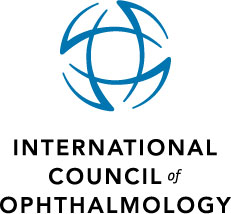| Divergent Concomitant Strabismus, Alternating Exotropia | |
| The patient has a large angle exotropia that is greater than 45 prism diopters (PD). In this photo, the Krimsky method is employed to measure the exotropia. The light reflex is almost centered with 45PD (Base inside), which is the extent of the horizontal prism bar shown. Some physicians also employ the MODIFIED Krimsky method where the prism is placed over the best or dominant eye. In this patient, using a 25 PD prism over EACH eye (50 PD in total), allowed for the light reflex to be perfectly centered (not shown in photo). Prism amounts can be added to each other when over each eye or a vertical and horizontal prism are stacked on top of each other but not when two horizontal or two vertical prisms are stacked on top of one eye. The patient's vision is 20/25 OU. The patient complained of diplopia with prism correction greater than 40PD, suggesting a possible anomalous retinal correspondence (ARC). This can be assessed with various tests. | |
| Luviano, Damien, M.D., SETMA Diabetes Center of Excellence¦2, Beaumont, USA | |
| H50.1 | |
| Strabismus, Ocular Motility Disorders -> Exodeviations -> Case: Divergent Concomitant Strabismus | |
| 7872 |
|
|||||||||||||||
Divergent Concomitant Strabismus, Alternating Exotropia-------------------------- -------------------------- -------------------------- -------------------------- -------------------------- -------------------------- -------------------------- -------------------------- -------------------------- -------------------------- -------------------------- -------------------------- |
|
||||||||||||||




